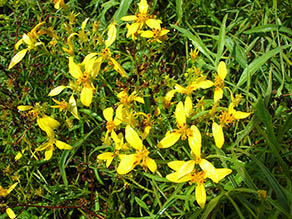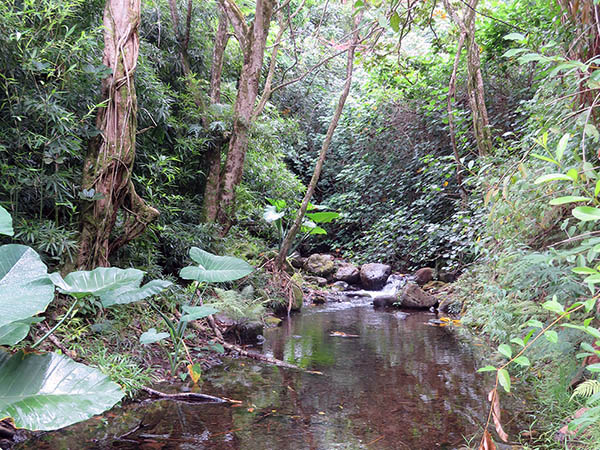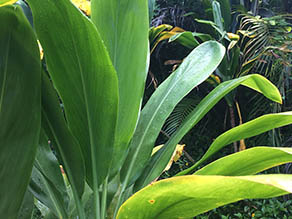 |
 |
 |
 |
||||||
|
|
|
|
|
|
|
|
|
|
 |
“Sam Lono was a kahuna lā‘au lapa‘au,” Rocky says. "We were good friends growing up. Sam and his brother Paul and their ‘ohana. Sam lived up lived mauka in ‘Ioleka‘a, we lived makai, so Jerry, my husband, would take fish up to Sam. He liked it and we’d exchange, he had these water snails, like opihis. He was a kahuna lā‘au lapa‘au. “My grandmother was also a kahuna lā‘au lapa‘au, but Sam was also kahuna ‘anā‘anā [sorcery]. I was always taught not to do ana‘anā, to pule that away. My sister, who passed away a couple of years ago, she would say that as a little girl, her tūtū—my grandmother—used to get an herb from the mountain and send my uncle—my father’s youngest brother—to the ocean. So there was one type of limu and one type of herb in the mountain that she would mix together for some kind of medicinal use.” 
“When we were little, my grandparents used only herbal medicines for us,” Emalia remembers. “I mean, their refrigerator was full of ‘uhaloa that they made for coughs and colds and asthma, and so we were treated with those kinds of medicines growing up. My grandparents never saw a doctor until they were in their 70s. By that time they had diabetes so it took a toll on them already. They died from complications of diabetes. And that’s carried over: a lot of us have diabetes and are under medical care.” “Oh, there’s all kind of medicine,” Alice says. The ko‘oko‘olau is the tea. Some of the kids, they grew up, didn’t drink milk. they drink that koko‘olau tea. Koko‘olau that was their milk, no milk. We were fortunate we had the dairy across so we didn’t worry but some of our neighbors, their milk was tea. “And they use a banana. They cut the banana leaf and they let the sap drip and if you have hoof-and-mouth sick, whatever, they take that. Everybody would just wrap it up, wipe up on, my mom would make us drink it, but you know one in the morning, one at night, one in the morning, five times a day. “Even the lauhala fruit, they used that for the ladies that was used to be pregnant. I don't know what they did with that. But if they had a sickness that cannot handle, keep the babies, and they give them the medicine. I never had that problem. I had nine children. 
“But all these plants, now if you tell the kids, they make a funny face. My kids, they still give my grandchildren the banana, and the laukahi. The laukahi is good for diabetes. It flushes you out, and it comes in those nice leaves. I think I have seen it down by the lo‘i. You have to boil five or seven cups of water with the leaf. You let the water boil then you throw the leaf in and shut it off and it makes a tea, and that flushes out and it helps the kidneys. We drank it. I drank it before. It really got no taste unless you add sugar or something, but that’s no fair, you cannot have sugar if your drinking it for medicine. “People take noni for just like the kukui nut, the kukui nut they kind a scrape and that’s like the banana. They do the hoof-and-mouth with kukui nut too, and that’s bitter but that works. Just rub, kukui nut, just rub, yeah. If you eat it, oh my god. Might as well having some Ex-Lax.” Plant medicine could also be applied externally: “There was one for the bones that we didn’t have to go to a doctor. If we broke a bone or something we didn’t have to go to the doctor. My mom them would take this one leaf and pound it all up. The trick about this thing is you have to shishi, and they use that shishi as water and they pound this leaf and they put this in a cloth and then they rub it all, so many times a day. They were rubbing. 
“And then they would chew the tī leaf, the shoot. They would chew that if you had a cut; chew that with salt put it in the cut, just take it and put it. Yeah, chew it with the salt and put it on your cut, no stitches, nothing. “Even if you got poked by a nail, that the rusty and all that, they should take the ginger and pound up, pound the ginger, put some oil and some salt, and make it hot, and just jam it right on your leg and three times, bam. The eating ginger, or you can use that same thing, ‘awapuhi ginger. It’s ginger, it’s what in that plant. What’s in that plant that you got, it works. Ask and tell me, it works.” “I studied with Aunty Alapa‘i Kahuena,” Kamaka says, “and she was very spiritual. She always emphasized the importance of that spiritual connection to the lā‘au. And being able to gain stronger relationships with the herbs that we use and that way we have greater conviction to help people believe. But if they don’t believe in the lā‘au, there is no sense we give them lā‘au. Papa ‘Auwae said that with the lā‘au, eighty percent is spiritual, twenty percent is the actual lā‘au. So that spiritual aspect is so important. “I gather my own lā‘au. I’m more of a type where people ask for my kōkua or my help, if they come in and ask, then I help them out. I can sometimes see it in some people that they might need my help, it’s not my kuleana to be pushing everything on everybody. If they come to me for help, then I’ll help get them what they need. Or if not, I’ll refer them to people who can help them. “Sometimes I just grow my own. Whatever lā‘au grows in my yard, or in my neighborhood, is what I use. I think that relationship with our environment and our community is important. “There is the ‘ōlelo no‘eau, ‘Ma ka hana ka ‘ike’—the knowing by doing, so a lot of working with the lā‘au is in the practice of using the lā‘au. We can gain our own personal experiences of what works for us. Because with that we gain a stronger testimony and create greater faith in the medicine and the herbs.”
|
 |
|||||||
 |
Use of plants is but one aspect of Hawaiian medicine. External treatments involving bodily manipulation also play an important role.
|
 |
||
 |
|
 |
||

|
 |
||||
|
||||
Copyright 2019 Pacific Worlds & Associates • Usage Policy • Webmaster |
||||


